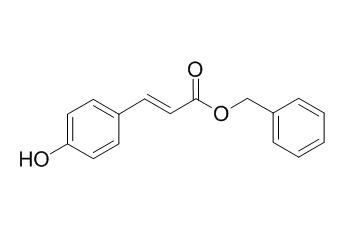Benzyl p-coumarate
Benzyl p-coumarate is a natiral product from poplar resins.
Inquire / Order:
manager@chemfaces.com
Technical Inquiries:
service@chemfaces.com
Tel:
+86-27-84237783
Fax:
+86-27-84254680
Address:
1 Building, No. 83, CheCheng Rd., Wuhan Economic and Technological Development Zone, Wuhan, Hubei 430056, PRC
Providing storage is as stated on the product vial and the vial is kept tightly sealed, the product can be stored for up to
24 months(2-8C).
Wherever possible, you should prepare and use solutions on the same day. However, if you need to make up stock solutions in advance, we recommend that you store the solution as aliquots in tightly sealed vials at -20C. Generally, these will be useable for up to two weeks. Before use, and prior to opening the vial we recommend that you allow your product to equilibrate to room temperature for at least 1 hour.
Need more advice on solubility, usage and handling? Please email to: service@chemfaces.com
The packaging of the product may have turned upside down during transportation, resulting in the natural compounds adhering to the neck or cap of the vial. take the vial out of its packaging and gently shake to let the compounds fall to the bottom of the vial. for liquid products, centrifuge at 200-500 RPM to gather the liquid at the bottom of the vial. try to avoid loss or contamination during handling.
Pharmaceutics.2020, 12(9):882.
J Biochem Mol Toxicol.2017, 31(9)
Horticulture Research2023, uhad164.
Mol Biol Rep.2022, doi: 10.1007
Int J Cosmet Sci.2023, 45(2):155-165.
Food Chem.2024, 436:137768.
Ind Crops Prod.2014, 62:173-178
Hortic Res.2023, 10(9):uhad154.
J of Applied Biological Chem.2020, 63(2):147-152
Patanjali Research Foundation2024, ssrn.4807357
Related and Featured Products
Food & Fermentation Industries, 2007, 33(7):162-166.
A Comparative Study on Chemical Compositions of Chinese Propolis and Poplar Resin[Reference:
WebLink]
METHODS AND RESULTS:
Chemical compositions of the ethanolic extracts of 30 propolis samples from Shaanxi, Henna, Hubei, Hebei, Liaoning, Zhejiang Shandong and Gansu provinces and two poplar resin samples were determined using reversed-phase high-performance liquid chromatography (RPHPLC)-mass spectrometry with photodiode array detector.
CONCLUSIONS:
The results showed that chemical compositions of the tested propolis samples were the same and pinocembrin, chrysin and galangin were the dominant flavonoids in the tested propolis and poplar resins. In addition, phenethyl caffeate, benzyl caffeate, Benzyl p-coumarate, 2-methyl-2-butenyl ferulate, piobanksin 3-propanoate, 2-methyl-2-butenyl p-coumarate, cinnamyl caffeate, trans-ferulic acid and 2-methyl-2-butenyl ferulate were also identified both in chinese propolis and poplar resins.



